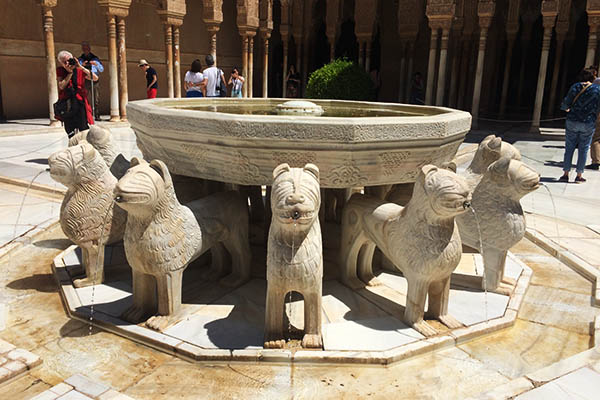
The courtyard of the Palace of the Lion in Granada. Photo courtesy Muneeza Shamsie
Linking the past and present of Granada, Cordoba and Seville
This summer, my husband Saleem and I, together with our daughter Kamila, decided to visit Spain. We flew to Malaga for an overnight stop and traveled onwards to Granada, Cordoba and Seville in Andalusia. The original word “al-Andalus” is the Arabic term for Spain (Iberia), which the Arabs conquered in 711 CE. There, a symbiotic Euro-Arab culture flourished until the Fall of Granada in 1492—the last Arab kingdom in Spain—the same year Christopher Columbus discovered the New World. Reminders of that historical past permeated our entire journey.
The many plants the Arabs introduced into Europe include the palm trees seen in Malaga, dates sold in tourist shops; and the glorious frangipani outside the 16th century Malaga Cathedral. This coastal town once belonged to the rich and fabled kingdom of Granada, ruled by the Nasirid dynasty from 1230-1492; their capital, Granada, was high up in the hills, on the lower slopes of the snow-topped Sierra Nevada. The word “Granada” means “pomegranate” which is also the city’s emblem and throughout our Andalusia trip, we stayed in hotels near recently restored historic areas and UNESCO World Heritage sites.
In Granada, a side street (with no traffic except the occasional cab) led us into center of Nasirid Granada and its cobblestone lanes. Here, the only surviving Nasirid building is the Madrassa—the city’s first university—built in 1349 by Sultan Yusuf I. Only one original room remains, however, the spectacular prayer room with a mihrab framed by a stunning archway. The intricate plaster work, carvings, calligraphy, floral and geometric patterns in tones of blue, beige and white are united with mathematical precision, as is the octagonal dome above. The Madrassa once housed a magnificent library, which was publicly burnt along with thousands of Arabic books after The Fall of Granada, on the orders of the victorious Queen Isabella of Castile and Cardinal Ximenes, her adviser.
Queen Isabella and her husband, King Ferdinand of Aragon, victors of the “Reconquesta” vanquishing Hispano-Muslim power, are buried in the elaborate Chapel Royal. This adjoins Granada Cathedral, the world’s fourth largest cathedral, which Isabella intiated on top of Granada Mosque. Her successors Charles V, Holy Roman Emperor, and his son Philip II continued the construction which combines Baroque and Renaissance styles and demonstrates the wealth of 16th century Spain. The pristine white walls and columns highlight gold decorations on organ pipes, murals, friezes, balconies and small beautiful chapels. There are marble sculptures or paintings too, sometimes embedded in intricate wood carvings. The pulpit and the altar stand against a backdrop of pillars, balconies, and stained glass windows, under a huge dome.
To the city’s north, we walked up the steep Albayzin, a historic locality with narrow lanes and houses clustered together, famous for their beautiful courtyards. The River Darro flows past in the ravine below. In Nasirid times, Christians, Jews and Muslims, including royalty and high officials lived in the Albayzin. Afterwards, it was tarred a rebellious “Moorish locality” and consigned to centuries of neglect. In the 1930s, poet and playwright Frederico Garcia Lorca lived in the upper part of the Albayzin, now a tourist area, and we dined at a restaurant with a spectacular view of the floodlit Alhambra on the hill opposite.
The Alhambra (al’qala al’amra—the red castle) was always a strategic site, but Muhammed I, the first Nasirid ruler, built palaces, public buildings and a military base, embodying the zenith of a brilliant Hispano-Arab culture. His successors also created a summer palace, the Generalife (janat al’arifa) on a nearby hill. In the 19th century this neglected but still-beautiful site attracted many Romantics, including Washington Irving, and now the palace is approached through Romantic-style gardens with high hedges, clipped shrubs, fountains and carefully planned beds of flowers.
Inside the Generalife, we stepped into an Islamic courtyard, edged with arches and pillars with a glistening channel of water in the center, lined with fountains and flowers. A cool breeze blew across the arched windows on either side, with magnificent views of Granada and the countryside. The Nasirid royals came here for relaxation. The palace is remarkable, as are those in Nasirid Alhambra, for the use of water for aesthetics and to feed a complex hydraulic system.
We walked to the Alhambra, through stone arches, past cypress, palm and orange trees. Our guide said that Charles V wanted to make Granada the capital and ordered a domed Renaissance palace. But he made Madrid his capital instead. This grand building was subsequently never finished: it leads into a vast circular space—with no roof. The palace now houses two museums; and continues to obscure the nearby Nasirid palaces, reached through a side entrance.
I was quite unprepared for the spellbinding reality of the Nasirid palaces. The power of that famous tilework of bright diagonals lined with plasterwork featuring intricate calligraphy and geometric patterns is supplemented with alcoves covered with intricate carvings and designs. It all comes together in the dramatic courtyard, Court of the Myrtles, with a pool lined with clipped green myrtles reflecting arches and columns. This is located in the Palace of Comares, which boasts the Alhambra’s highest tower, in which Yusuf I created the breathtaking Hall of the Ambassadors with calligraphy, tiles, and geometric patterns covering the walls, and a high ceiling with arched windows filtering light.
None of this can equal the courtyard in the Palace of the Lion and its brilliant interplay of exquisite multiple arches and the central circular fountain encircled by white marble lions. This was a family palace with ornate work covering private rooms, corridors and alcoves. The entertainment area has a particularly unusual ceiling with mediaeval European paintings. The Sultana’s suite was quite spectacular, including the hall with low-arched windows, where the Sultana(s) liked to sit and enjoy the breeze and the view of the countryside. Alas, the breeze and view is blocked by Charles V’s palace, embodying the ‘blocking’ of a long Euro-Arab past in European history.
In 756, Umayyad Abd-al Rahman I ruled over much of Iberia and made Cordoba his capital: it became the largest city in Europe, celebrated for culture, learning and economic power. Cordoba is much lower than Granada and thus warmer, and stands on the banks of the river Guadalquivir (originally Wadi-al-Kabir). We wandered through its attractive old Jewish Quarter; strolled through squares shaded by trees and saw some horse carriages ply the area (no cars). In the evening, at the Royal Stables, we saw a spectacular horse show by its Andalusian horses. The riders were clad in 16th century attire—a tribute to Philip II who set up these stables and created a unique Spanish thoroughbred.
We then visited Vania Palace, owned by leading family for 500 years and remarkable for its 12 courtyards. There were ponds, pools, statues, fountains and countless potted plants including spider plants, monsteria, ferns, begonia—and orange trees shaped into climbers covering some courtyard walls.
Of course the highlight of our Cordoba trip was the Great Mosque (known today as Mosque-Cathedral) built in 785 by Abd-al Rahman I. In 1236, Ferdinand III of Castile conquered Cordoba and duly turned the mosque into a cathedral. In the 1930s Sir Muhammed Iqbal obtained special permission to pray there. His lyrical poem “Masjid-e-Qurtaba” is a brilliant contemplation of it beauty, of past and present, faith and eternity.
Once again nothing quite prepared me for the sheer wonder of it. I was spellbound by the power and ethereal quality of the prayer hall, the row upon row of elegant columns topped with double, red and white, horseshoe-arches; they assume new dimensions and vistas viewed from different angles, creating a sense of infinity. The high ceilings are embossed with geometric patterns; and the windows covered with patterns in stained glass.
The tour de force remains the spectacular mihrab with its horseshoe arch, located in an octagonal space topped by a beautiful dome. The mihrab shimmers with a mosaic pattern of gold and different colors and shades. The whole is defined by the bold Quranic calligraphy above.
A notice at the Mosque-Cathedral entrance reminds visitors that this is a Christian place of worship and no one else can pray there. There are images of Christ and the Madonna and of Saints (often wielding righteous swords) on pillars, walls, recesses and alcoves. Right in the middle stands the Cathedral—a completely alien building-within-a-building: vaulted ceilings, choir-stalls, organ, altar, pulpit, carvings and paintings. The sense of being in a church/cathedral permeates this space, but a few steps take you right back into the timeless architecture of a mosque. The entrance and the exit traverse a spacious courtyard with 98 orange trees and a large cistern, where Muslims once performed their ablutions.
In 936, Abd al-Rahman III converted the prosperous Emirate of Cordoba into a Caliphate and created a magnificent new palace-city, Madinat-al-Zahra, outside Cordoba on three levels on the slopes of a hill facing the Guadalquivir valley. Around 1010, it was sacked and burnt by Muslim Berbers in a civil war. The city was forgotten and buried under mud and water. Excavations finally began in 1910. A new museum gives an introduction to this archaeological wonder where some features such as walls, archways and rooms have been reconstructed, though only a fraction has been unearthed so far. To our disappointment, Abd al-Rahman III’s palace and magnificent gardens were closed for renovations when we visited.
The Umayyad rule extended to Seville in lower Guadalquivir regions, but the Caliphate collapsed in the 11th century. Seville became a small, independent Muslim kingdom (taifa) until its conquest by Castile in 1235. The discovery of the New World then transformed Seville: it became an economic hub, the center of trade and commerce with the Americas. Today, Seville is a bigger, busier town than Cordoba and Granada. A monument to Christopher Columbus stands in the fountain of a beautiful park, its two columns linked by a sculpture of Columbus’s ship and inscribed with ‘Ferdinand’ and ‘Isabella,’ the names of the Spanish rulers who sponsored his journey. A zig-zag of lanes took us past Moorish-style houses to the venue of an enjoyable, but not brilliant, flamenco: a dance form with the same roots as the kathak, since it was brought here by gypsies—nomads from the Punjab.
Seville Cathedral stands across the square. The Giralda, its imposing bell tower, was once a unique minaret: a system of winding ramps inside enabled the muezzin to ride his horse up its great height and give the call for prayer. The mosque was used as cathedral under Christian rule for almost 200 years. In the 16th century, Seville’s economic boom led to new construction, transforming it into the largest Gothic cathedral in the world. The building includes wonderful stained glass windows, magnificent paintings and statues, fine woodwork, a touch of gilt, gold and metal, alcoves and recesses and doors leading into inner chapel. The tomb of Christopher Columbus, built in 1890, is remarkable for its grandeur: it portrays his bier being carried by four crowned figures representing the united kingdoms of Christian Spain: Leon, Castile, Aragon and Navarre.
Seville’s Alcazar Palace is still used by the Spanish royal family and is the oldest inhabited palace in Europe. Above the entrance archway stands the royal symbol, a crowned lion. The Alcazar dates back to the early Umayyad’s, but after it fell to Castile, the palace drew on Gothic Renaissance and Islamic traditions among others; and includes a room lined with very fine 16th century Belgian tapestries. However, the relationship between Christians and Muslims here was rather more complex than the power-and-conquest narratives of building cathedrals on mosques would have you believe. In fact, many held Hispano-Muslim culture in high regard until the expulsion of the Moors from Spain. In the 14th century, Peter I of Castile added an entire section to the Alcazar in the Moorish style with Islamic gardens, fluted archways, exquisite tiles on the walls and the floors. The Alcazar appears to provide more space to plants rather than the building itself: everywhere I looked, there would be an opening, an archway, or even a corridor that would reveal a vista that included plants: the whole building is interspersed with courtyards, patios and vast gardens with clipped hedges, cypress trees, bougainvillea, jasmine, palms and much else.
Interestingly, all this while, our guides or guidebooks emphasized the Christian vs. Muslim conflict—but many scholars and writers today are exploring the paradox and “lost” narratives of that distant past. Poet Shadab Zeest Hashmi’s The Baker of Tarifa includes an extraordinary historical detail: that the conquering Queen Isabella wore Arab attire on the day she took the keys of Granada from its defeated, last Muslim king.
Shamsie is author of Hybrid Tapestries: A Development of Pakistani Literature in English and in 2016 guest edited The Journal of Postcolonial Writing’s Special Issue Al Andalus
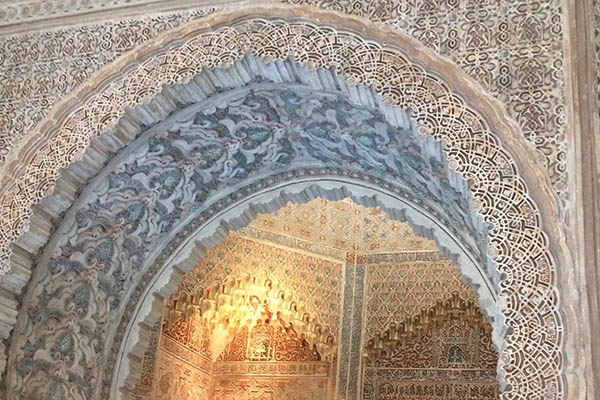 The entrance to the prayer room in the Madrassa, Granada. Photo courtesy Muneeza Shamsie
The entrance to the prayer room in the Madrassa, Granada. Photo courtesy Muneeza Shamsie
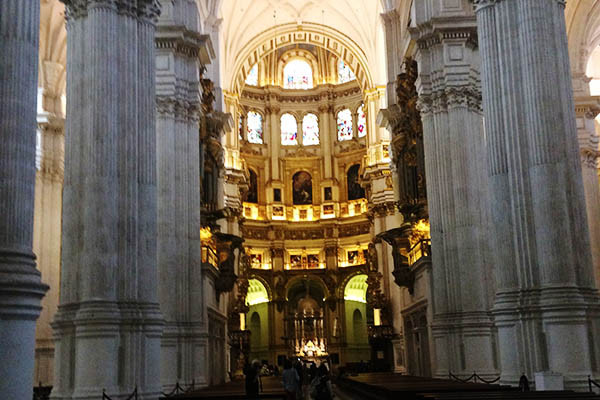 The Granada Cathedral. Photo courtesy Muneeza Shamsie
The Granada Cathedral. Photo courtesy Muneeza Shamsie
 The courtyard of the Palace of the Lion in Granada. Photo courtesy Muneeza Shamsie
The courtyard of the Palace of the Lion in Granada. Photo courtesy Muneeza Shamsie
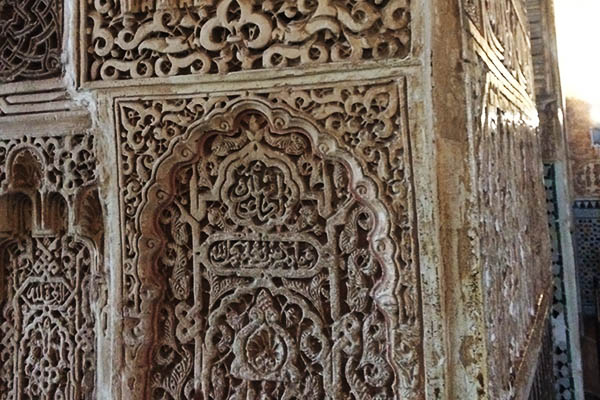 The Hall of the Ambassadors in the Palace of Comares. Photo courtesy Muneeza Shamsie
The Hall of the Ambassadors in the Palace of Comares. Photo courtesy Muneeza Shamsie
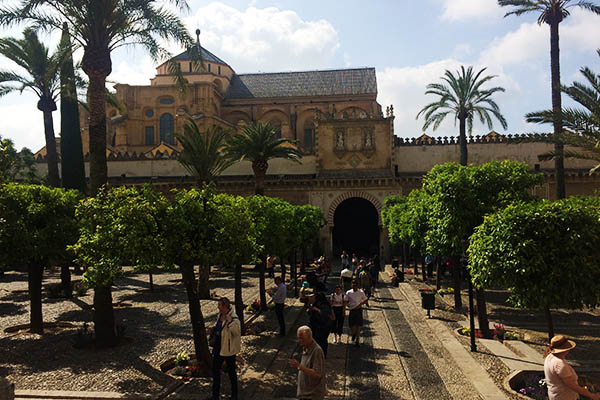 The Cordoba mosque-cathedral, with its courtyard full of orange trees. Photo courtesy Muneeza Shamsie
The Cordoba mosque-cathedral, with its courtyard full of orange trees. Photo courtesy Muneeza Shamsie
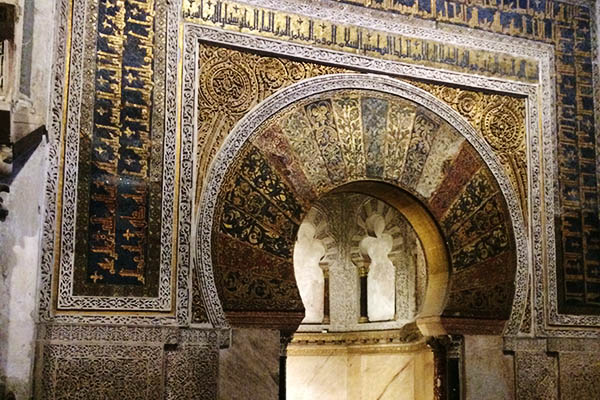 Detail of the mihrab at the Great Mosque in Cordoba. Photo courtesy Muneeza Shamsie
Detail of the mihrab at the Great Mosque in Cordoba. Photo courtesy Muneeza Shamsie
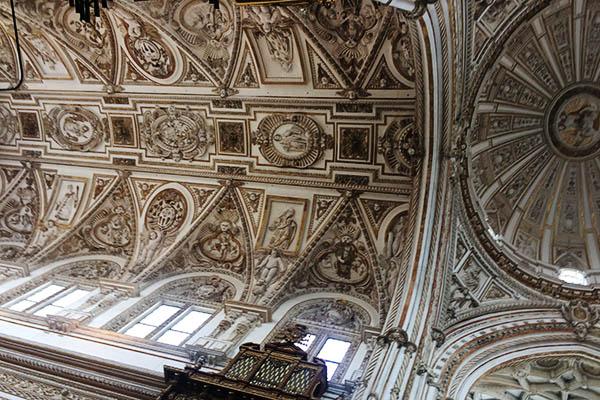 Detail of the ceiling of the Cordoba cathedral. Photo courtesy Muneeza Shamsie
Detail of the ceiling of the Cordoba cathedral. Photo courtesy Muneeza Shamsie
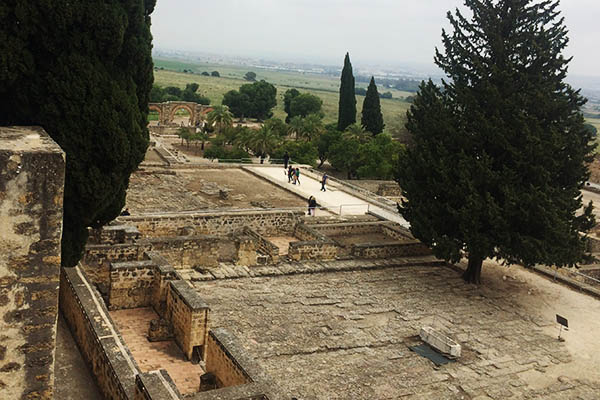 The Madinat-al-Zahra, currently being excavated and restored. Photo courtesy Muneeza Shamsie
The Madinat-al-Zahra, currently being excavated and restored. Photo courtesy Muneeza Shamsie
 A monument to Christopher Columbus in Seville. Photo courtesy Muneeza Shamsie
A monument to Christopher Columbus in Seville. Photo courtesy Muneeza Shamsie
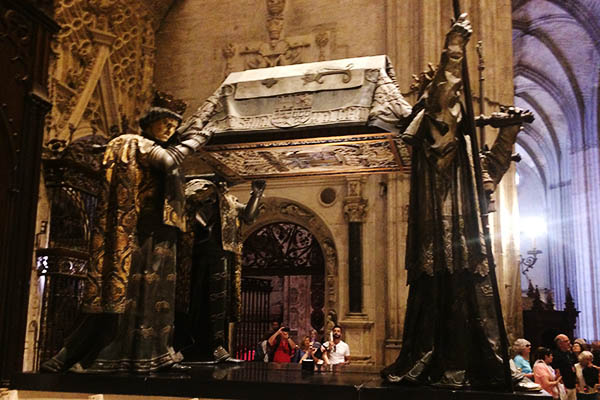 The tomb of Christopher Columbus with his bier being carried by four crowned figures representing the united kingdoms of Christian Spain: Leon, Castile, Aragon and Navarre. Photo courtesy Muneeza Shamsie
The tomb of Christopher Columbus with his bier being carried by four crowned figures representing the united kingdoms of Christian Spain: Leon, Castile, Aragon and Navarre. Photo courtesy Muneeza Shamsie
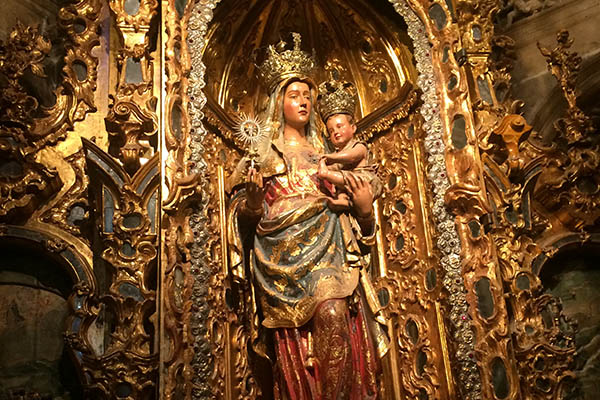 Detail of a statue located in the Seville Cathedral. Photo courtesy Muneeza Shamsie
Detail of a statue located in the Seville Cathedral. Photo courtesy Muneeza Shamsie

1 comment
You completely forgot to mention the Moroccan Almohad dynasty who unified Al-andalus and Maghreb. This powerful dynasty built La giralda and many Alcazar civil works in Andalucia. This is under this dynasty that Ibn Rushd and Ibn tufayl were flourishing.
Again you just highlight Arabic dynasties like Ummeyad but you completely overlook Maghrebi ones like Almohad, Almoravids, Merinid, Zianid and even Nasrid are suspected to be amazigh (berber)